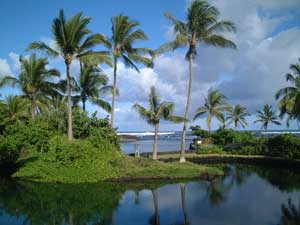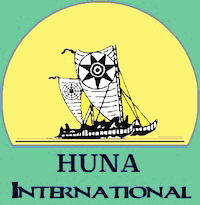Information
Huna International

Big Island Info For Students
Go straight to Useful Links
The information below is provided as a service to students and visitors, and Huna International assumes no
responsibility for your personal experience if you use it.
NOTE: Please check the location of workshops as they may be in different places. Huna
International's center is now in Hawaiian Paradise Park on the coast east of Hilo.
BIG ISLAND OVERVIEW
The Big Island (also called "Hawaii Island") is the largest of the eight major Hawaiian islands. It is 4000
square miles in size (10,360 kilometers), almost as large as the US State of Connecticut, and eight times
larger than Kauai.
The island can be divided into several areas.
-
West: This includes the Kona Coast, a primary tourist destination centered on the town of
Kailua-Kona, with the main airport, a lot of shopping areas, and many hotels and restaurants of all kinds.
Most of the swimmable beaches are on this side, and there are a lot of cultural sites to visit. The
weather is usually sunny and warm.
-
North: There are large resort hotels and cultural sites in the northwest, ranches and the mainly
residential town of Waimea in the northeast. The northeast also includes the spectacular valley of Waipi'o
and the high volcanic mountain of Mauna Kea. Weather is changeable.
-
South: The southernmost point in the USA, black sand beaches, the high volcanic mountain of Mauna
Loa, and plenty of open country are in the southwest. This area is usually sunny and warm. The southeast
includes Hilo, the second largest town in the State of Hawaii, the Hilo airport, natural warm pools on the
coast, jungles, rainforest, Kilauea Volcano, and the Heartquarters of Aloha International. The weather is
changeable, and frequently rainy.
NOTE: Huna International courses are located on the Northeast side of the Big Island (Hilo,
Puna) unless otherwise noted.
WHAT TO BRING
Bring shorts, swimwear, sandals, hat, sunglasses, sun lotion, and your favorite mosquito repellant for
hot days at the coast, as well as long pants, covered shoes, and jacket or sweater for cool to chilly
days in the mountains. Bring good walking shoes (tennis shoes are okay) for hikes. It may rain at any
time, so a mini-umbrella may be useful (for too much sun, also). Anything else is optional. Dressing
up
for dinner or a luau means a shirt and trousers for men and a light dress or slacks and a top for
women.
Plan to add a sweater or jacket depending on the weather or the location.
Air Transportation
Unless you have your own boat, or are on a cruise, the only way to reach the Big Island is by air.
United Airlines, American Airlines, and Hawaiian Airlines, among others, fly to the airport in
Kailua-Kona from Honolulu and various airports on the Mainland USA. Flights on some airlines go
directly
from Honolulu to Hilo, and others go directly to Hilo without stopping at Honolulu. Please note that
the
Outer Island (all but Oahu) airports do not have any currency exchange services. Also note that Aloha
International courses take place on the Southeastern side of the island, and it is about a three-hour
drive from Kailua-Kona to Hilo whether you take the southern or northern route.
Local Transportation
Public bus transportation on the Big Island is not bad, but it may not be going where you want to go
when you want to go there, so a car rental is strongly recommended, especially for short stays. Taxi
service is available, but is very expensive. Uber has begun service on the Big Island, but we do not
know the rates. Some airlines have special offers that include a car at a lower price than usual. If
you
are coming for one of our courses and you do not drive, we will do our best to help you get to the
classes, but we cannot guarantee transportation. The town of Hilo is about twenty-seven miles
northeast
of the town of Volcano. Due to traffic it can take 40-60 minutes to get to or from Hilo, the same for
Pahoa, and at least an hour for Kalapana.
Lodging
There is no airport service for finding lodging, as in many airports near large cities, so it is wise
to
arrange for lodging before you arrive. Big Island has high-end resort hotels, medium-priced to cheap
hotels, hostels, and lots of bed and breakfast lodgings at various prices. Please note that a lot of
so-called "bed and breakfast" lodgings do not provide any food, so ask in advance. For specific
lodging
information see the links below or do your own search on the Web. The most convenient lodging
locations
for our courses would be in and around Volcano Village. For some courses we may have specific
recommendations. Note that areas below 2000 feet(610 m)may have a noise problem with coqui frogs.
The Social Environment
Big Island is mostly rural. The population is about 200,000 scattered mostly around the coast and
concentrated in a few small towns. Overall, sidewalks and wheelchair ramps are very limited except in
the largest towns. It is the custom of most residents to remove their footgear when they enter a home,
but not a store. There is usually some kind of event going on in the evening in the main towns.
The Physical Environment
The Big Island is a tropical island, with a mixture of palm-fringed beaches, lush rainforests, high
mountains (Mauna Kea is about 14,000 feet high (4000+ meters), lava deserts, and the most active
volcano
on earth. The tropical sun can burn even through cloud cover, so bring what's necessary if you have
sensitive skin.
Weather
At its best, a balmy 77F (25C), with blue skies, puffy white clouds, soft breezes and gentle waves. At
its worst, either stormy and rainy with high waves, or very hot and humid with waves doing whatever
they
feel like. The weather is very changeable, and there is no guarantee of any kind for any season.
Evenings in the higher elevations (Volcano Village is at 3700 feet or 1128 meters) can get chilly (50F
or 10C, and lower).
Swimming
You must always use caution, because the waves and currents are
unpredictable, even on a calm day. The rules are "If in doubt, don't go out" and "If you do go out,
look
about." People are lost every year, either by large waves they weren't looking at or by riptides,
especially in the winter season from November to March. If you should get caught in a riptide (a
strong
current that pulls you out to sea for up to a hundred yards or so) just go with it until it weakens
and
swim along the shore until you can get back in.
Wildlife
No snakes and nothing larger than wild boar, which you are unlikely to see unless you go hunting for
it
in the mountains. Lots of birds, and lots of insects. You are most likely to encounter mosquitoes,
geckos (small lizards that often live indoors), cockroaches, spiders of various sizes, and, possibly,
a
centipede or two. You may also encounter wild chickens and coqui frogs. When you come for a course you
will learn how to deal with insects using Huna.
USEFUL LINKS
Big Island Bus Information - General information, plus specific
schedules for download, including Volcano stops.
County of Hawaii Visitor Site - Sites, attractions, camping
permits, and bus schedule.
Big Island Travel & Tourism - Just what it says.
Hawaii.com - More of the above.
Hawaii Island B&B Association - Bed and breakfast
links.
Big Island Hawaii Bed and
Breakfast - Bed and breakfast links.
Hilo
Hotels - Hotels in Hilo.
Coconut Grill Restaurant - next
to
Hilo Bay Hotel, low key, good food, a great place for trying local dishes. Look for the tsunami lines on
the inside window.
Big Island Travel Guide - getting around the Big Island,
itineraries, and activities.
STUDENT PICKS
(Some of these cottages are not in walking distance of our center, even though the main office might be,
so check on the location of your rental if you can)
Volcano Lodging - A variety of cottages in Volcano Village,
close to our center. Owner is offering a 10% discount to our students for their entire stay.
Volcano Inn - Clean, comfortable, reasonable
cottages.
The Holo Holo In - Inexpensive hostel in Volcano
Village.
Aloha Junction B&B - "Very good group rates."
NOTE
Volcano Hale is NOT recommended because of poor security.
|


